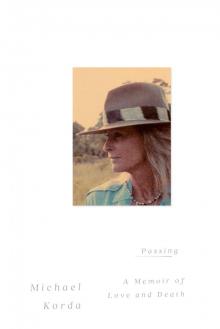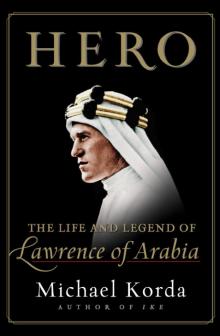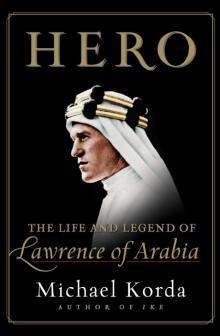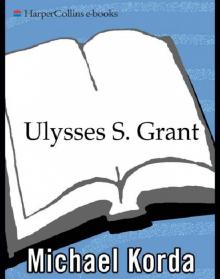- Home
- Michael Korda
Hero Page 19
Hero Read online
Page 19
It is very significant that at the same time Lawrence was gently deflecting Vyvyan Richards’s advances, while retaining Richards as a friend—and actually making plans for the two of them to share a William Morris-inspired country cottage where they would hand-print aesthetically satisfying volumes, a cottage complete with separate “shut beds” marked “Meum” and “Tuam"—Lawrence made the mistake of proposing marriage to a young woman.
Lawrence’s first sight of Janet Laurie has a certain innocent sexual ambivalence to it. In the spring of 1894, when the Lawrences moved to New Forest, the Lauries were neighbors. Apparently, Janet’s parents had wanted a son, and therefore had the little girl’s hair cut short, and dressed her in a boy’s clothes—one of those strange decisions that, at the time, often made otherwise quite ordinary English families seem bizarre to foreigners. One Sunday morning, when the Lawrences were attending church, Ned saw Janet sitting in a pew in front of him, and said to his nanny, “What a naughty little boy to keep his hat on in church.” Janet turned around, stuck her tongue out at him, and said, “I’m not a boy, I’m a girl.” “And a very rude little girl,” Nanny said predictably, but a friendship had been struck, and Janet soon became a frequent visitor at Langley Lodge. Although Sarah was generally dismissive of girls—"We could never be bothered with girls in our house,” she would tell the poet Robert Graves, when he came to write a biography of T. E. Lawrence after the war—she seems to have made an exception for Janet, whom Ned particularly liked, since Janet was something of a tomboy.
Over the years, Janet became a friend of all the Lawrence boys; for a time, she was at a boarding school in Oxford, and although she went home after the death of her father, she continued to pay frequent visits to 2 Polstead Road, and “sometimes stayed there.” She seems to have played the role of a sister to all the boys, and to have been accepted by their parents almost as one of the family.
A photograph of Janet taken when she might have been about seventeen shows an attractive young woman, with a striking profile, very lively eyes, and a full mouth, dressed in a white blouse rather like a man’s shirt, with a tie, possibly the summer uniform of her school. She manages to look severe and sensual at the same time. Everybody who met her agreed that she was “a lovely girl,” as well as being good-natured and fun. Sarah went so far as to hope that her eldest son, Bob, might marry Janet one day, and no doubt did what she could to encourage that, but Bob was too serious and easily shocked to attract Janet. Ned would later say of his older brother, who would become a missionary doctor, “He is illuminated from inside, not from out. His face very often shines like a lamp.” Janet set her cap at the taller and better-looking Will instead, incurring Sarah’s displeasure, since Sarah disliked having her plans thwarted.
Ned was “more than two years younger” than Janet, and considerably shorter. She saw him as a beloved and mischievous younger brother, always up to such tricks as sneaking her into his room at Jesus for tea, or egging her on to toss a sugar cube through the open window of a don. She was therefore surprised when Ned abruptly proposed to her one evening after dinner, though she might have guessed that something was up when Ned waited until everybody else had left the dining room, then carefully bolted the door. Given Ned’s taste for practical jokes, she very likely assumed that she was about to become the victim of one, and was therefore understandably astonished when he asked her to marry him, without even a preliminary kiss, indeed without even looking her in the eye. Although she would later say she realized at once that he was serious, her immediate reaction, perhaps out of shock, was to laugh. A moment of dreadful embarrassment followed—there they were, locked in the dining room, with the rest of the Lawrence family no doubt wondering what had become of them. Ned was deeply hurt, but he confined himself to saying, “Oh, I see,” and seems afterward never to have held it against her.
It is a scene straight out of an English farce, but it must have been an awful moment for Lawrence. Some of those who have written about himhave raised the possibility that Janet’s refusal to marry him was what drove him to spend years in the Middle East in the company of men, but that may be attaching too much importance to the incident. It seems more likely that Lawrence was attempting to sort out his problems with Vyvyan Richards’s increasing emotional dependency by abruptly proposing to Janet—he was always one for the big, dramatic, life-changing gesture. Whatever the case, Lawrence was never as ill at ease with women as has been claimed. Many of them, like Janet, were close friends, but in the end, Lawrence no more wanted a sexual relationship with a woman than he did with Richards.
It may be true that Lawrence “worshipped Janet from afar,” in later years, or that he referred to her to a friend as “the girl I adore,” but one should not read too much into this. His feelings for Clare Sydney Smith, the wife of his commanding officer toward the end of his life, were amiable enough, but there is no hint of any sexual interest on Lawrence’s part;* he was comfortable enough with women who had the capacity and patience to break through his rather brittle defenses, and yet respected his privacy and the orderly way he isolated himself when he felt a need for isolation. Except for the impulsive marriage proposal, he preferred to keep his distance, and cannot ever have imagined that he could live within the confines of marriage. One suspects that apart from the momentary damage to his amour propre, Lawrence was probably more relieved than upset when Janet turned him down.
Despite his peculiarities Lawrence, like other undergraduates, sought fun in breaking rules and regulations, and in the kind of pranks that seem daring and hilarious at the time, but may not necessarily seem so many years later when they are retold. Lawrence, like many undergraduates over the centuries, became an expert at climbing the walls and towers of the Oxford colleges, by day to take photographs and by night for his own amusement. One of his biographers, Robert Graves, claimed that Lawrence invented “the now classic climb from Balliol College to Keble College,” and it may be so.* His mother vigorously denied that Ned ever left his cottage in the garden to crawl around the roofs of Oxford at night; she said that he was always home by midnight. But since he often visited his friend the crammer, L. C. Jane, between midnight and four in the morning, this may be just another example of parental self-delusion. One friend told of Lawrence’s turning up in his rooms one evening, exhausted after having studied for forty-five hours nonstop without food or sleep, and firing a revolver loaded with blank cartridges out the window. This friend also told of Lawrence’s nearly drowning when he insisted on canoeing on the Cherwell during a winter flood. A famous feat of Lawrence’s was to lead a canoe trip at night down the Trill Mill stream, the sewer that runs under the streets of Oxford, firing blank cartridges up through the gratings in the streets above. Whether this was a first or not is hard to say—it has certainly been done again since.
Despite his eccentricities regarding nourishment and sleep, Lawrence’s years at Jesus do not seem all that different from the usual undergraduate experience. In those days, there was a deep social divide between “exhibitioners"—bright young men who had won a partial scholarship and were expected to work hard and earn a “First"—and young men from well-to-do families and public schools, for whom Oxford was more likely to be a social experience. Lawrence and his friends were clearly in the former group: basically serious, hardworking, and determined to do well, but not averse to the occasional prank—indeed Lawrence’s taste for practical jokes and for pulling the legs of people naive enough to believe him was apparently already fully developed, and would not invariably seem among his most endearing qualities.
In one way, however, Lawrence was very different from most undergraduates. He already had a very firm sense of what he wanted to do, andremarkable skill in meeting, and winning over, those who might one day be of use to him. It was also clear to Lawrence what he did not want to do, which was to become a don himself. This was just as well, since even the admiring Jane did not consider him “a scholar by temperament.” He still had Byronic fantasies of becom
ing a hero and of liberating a people—it was not yet clear which people he had in mind—and something more than a layman’s interest in military history, strategy, and tactics; but his interest in archaeology and medieval buildings was the strongest focus of his work at Oxford. Revealingly, Lawrence chose to write a thesis on medieval fortifications, about which he already knew a good deal, indeed perhaps more than his examiners. This subject would have the further advantage of allowing him to make use of his growing skill as a photographer and a cartographer, as well as providing a good reason for spending the vacations away from home. Warfare was never far from his mind, despite his other interests.
In preparation for his thesis, Lawrence did another of his marathon bicycle tours of France, sending home long letters, which often read as if he intended to incorporate them into the thesis later on. In the summer of 1907 he had taken a bicycle tour through northern France, traveling part of the route in the company of his father, who was on the way to join the rest of the Lawrence family on Jersey, in the Channel Isles, where they were spending their summer holiday. In the summer of 1908 he went alone on a much more ambitious 2,400-mile tour of France to examine the castles and fortresses he had not already seen. Once again, his letters (mostly to his mother) are formidably detailed, evincing Lawrence’s lifelong struggle to create a literary style of his own. His interest in the Middle East is clearly strong and growing. In his first letter he asks his mother to send him all the information she can get from the newspapers about political events in Turkey, where the sultan was under pressure from the “Young Turks” to grant a constitution. Lawrence refers to “the rubbish here that they call newspapers,” exhibiting exactly the same tone of impatience with the French that he would show toward them during the war, and afterward at the peace conference.
Ten days later, when he writes from Aigues-Mortes, in Provence, the fact that his attention is moving toward the Middle East is repeated, in a kind of poetic vision that prefigures his travels there: “I rode to Les Baux, a queer little ruined & dying town upon a lonely ‘olive sandalled’ mountain. Here I had a most delightful surprise. I was looking from the edge of a precipice down the valley far over the plain, watching the green changing into brown, & the brown into a grey line far away on the horizon, when suddenly the sun leaped from behind a cloud, & a sort of silver shiver passed over the grey: then I understood, & instinctively burst out with a cry of ‘T??assa, T??assa’ [Thalassa, Thalassa], that echoed down the valley & startled an eagle from the opposite hill.” The shout of the Greeks in Xenophon’s Anabasis when they at last glimpsed the Black Sea shining in front of them after their 1,000-mile retreat from what is now Iraq came naturally to a young man steeped in the classics, as Lawrence was; but, more important, it was his first distant glimpse of the Mediterranean.
Today, we can have no idea of what it then meant to a well-educated young Englishman—the Mediterranean is now just a few hours away by plane, and its shores are an endless array of tourist destinations—but in the first decade of the twentieth century, it was still the focal point of European imagination, culture, and respect for the past, a world at once classical and deeply romantic.
A day later, Lawrence reached the sea and bathed in it, writing afterward to his mother, “I felt at last that I had reached the way to the South, and all the glorious East: Greece, Carthage, Egypt, Tyre, Syria … they were all there, and all within reach…. I would accept a passage for Greece tomorrow.”
Perhaps fortunately, no such passage was offered, and Lawrence bicycled off to Nîmes, and from there by stages to Narbonne and Carcassonne. He was bronzed, thin, and fit, and he amazed the French by his feats of endurance and his diet—he ate 126 green plums in one day, or so he claimed. He was plagued only by dense clouds of mosquitoes (which, as any tourist to the region can attest, are still a problem today) and by Americans who overtipped tourist guides at the major sites. Perhaps in deference to his mother, Lawrence spent more time writing home about churches than castles. On this trip, as on all future ones, Lawrence carried a camera—whether his own or his father’s is not clear—and although he depreciates his own pictures, and says he expects to have to burn them, they are, like his drawings, far beyond the usual work of amateur photographers.
He arrived back at Oxford in the first week of September, having assembled a good part of what he needed in terms of his thesis, though he had not as yet decided what the exact theme would be—it would not be enough to have examined a large number of English and French fortresses and describe them in detail; he would need to develop a theory about them and demonstrate it convincingly. This was provided for him by C. F. Bell of the Ashmolean, when Lawrence was showing him the drawings and photographs from the summer trip. Bell suggested that Lawrence might study the question whether the earliest crusaders had brought back to Europe from the Middle East the pointed arch and vault that are the trademarks of medieval Gothic architecture, or whether instead they had brought these ideas with them to the Middle East, thus introducing those architectural elements into the Arab world. To Lawrence, one of the major attractions of his friend Bell’s idea lay in the fact that the distinguished Oxford scholar Charles Oman, author of The Art of War in the Middle Ages, took the latter point of view, which was therefore the orthodox answer. Nothing would be more likely to pique the examiners’ interest than an undergraduate’s attacking accepted or conventional wisdom, particularly when it was held by such a formidable figure as Oman, who was virtually a one-man historical industry. In fact, Lawrence could hardly have chosen a more tempting person to contradict than Professor Oman, whose influence was enormous in just those areas where Lawrence intended to make his career: history and archaeology. The “imp” in Lawrence must have been instantly aroused. And as if that were not temptation enough, it was immediately apparent to Lawrence that in order to write his thesis, he would need to journey to the Middle East and survey the crusaders’ castles for himself. Since this was exactly where he dreamed of going, the attraction was irresistible.
Bell’s boss D. G. Hogarth was an experienced traveler who had worked on archaeological digs in Syria, Egypt, Cyprus, and Crete, and Lawrence sensibly consulted him. Hogarth was discouraging—the summer was the wrong time of year to go; Lawrence would need money to hire a guide and servants to look after his tent and animals. Lawrence replied firmly that he was going, and intended to walk, not to ride, and do without a tent or servants altogether. “Europeans don’t walk in Syria,” Hogarth said; “it isn’t safe or pleasant.” Lawrence replied, “Well, I do,” and thus a lifelong friendship began.
Feeling that he had failed to convey the dangers facing travelers to the Middle East, Hogarth suggested that Lawrence write for advice to C. M. Doughty, the famous explorer of Arabia and author of the book Arabia Deserta, which would play an influential role in Lawrence’s life. Hogarth may not at this point have realized the degree to which danger and physical hardship constituted a challenge for Lawrence, or that testing his powers of endurance was as irresistible as taking a potshot at Professor Oman’s theories. Doughty’s reply was even more discouraging than Hogarth’s well-intentioned advice. In Doughty’s opinion, the heat in July and August would be unbearable; he described Syria as “a land of squalor,” considered travel on foot “out of the question,” warned of “ill-will” toward Europeans on the part of the local population, and suggested that at a minimum a mule or a horse and its owner were necessary.
Coming from a man who had taken the pilgrim route to Mecca under appalling conditions, and gone on to reach some of the most remote cities in central Arabia, it was advice that any sensible person would have taken; but Lawrence cheerfully replied that his “little pleasure trip” promised to be more interesting than he had bargained for, and proceeded to read Doughty’s book, which was nearly 600,000 words long and one of those great classics more talked about than read. Lawrence was strongly influenced by Doughty’s idiosyncratic, convoluted, somewhat antiquarian style, and by Doughty’s courage in following the
Bedouin through the desert from Damascus to Jidda without any of the privileges and comforts of a European traveler. Doughty, like Hogarth, would become a friend and admirer of Lawrence, always eager to hear of his young acolyte’s adventures.
Lawrence prepared himself methodically for the journey—first, he found an instructor in Arabic, a half-Irish, half-Arab Protestant clergyman. He also found, in the person of E. H. New, somebody who could improve his architectural drawings. In both cases he benefited from the fact that in Oxford there is always somebody, somewhere who is an expert on any subject, however abstruse—it is just a question of digging him or her out. Lawrence also dug out C. H. C. Pirie-Gordon, who had actually visited some of the castles Lawrence was interested in, and who lent Lawrence his own maps, on which he had made many useful notations.
Lawrence planned to wear “a lightweight suit with many pockets,” into which he put two thin shirts, a spare pair of socks, the all-important camera, and film packs. He also carried what his biographers describe as “a revolver,” but which may in fact have been a Mauser C96 7.63-millimeter automatic pistol,* with adjustable sights, which he mentions in one of his letters. His father gave him either £100 or £200 for the journey—it is hard to know which, but either way it represented a considerable sum of money at the time, $10,000 at least in contemporary terms. From this, Lawrence paid his passage, and bought what was then an expensive pistol and a camera that cost £40.

 Passing
Passing Another Life
Another Life Clouds of Glory
Clouds of Glory Hero: The Life and Legend of Lawrence of Arabia
Hero: The Life and Legend of Lawrence of Arabia Cat People
Cat People Hero
Hero With Wings Like Eagles: A History of the Battle of Britain
With Wings Like Eagles: A History of the Battle of Britain Ulysses S. Grant
Ulysses S. Grant